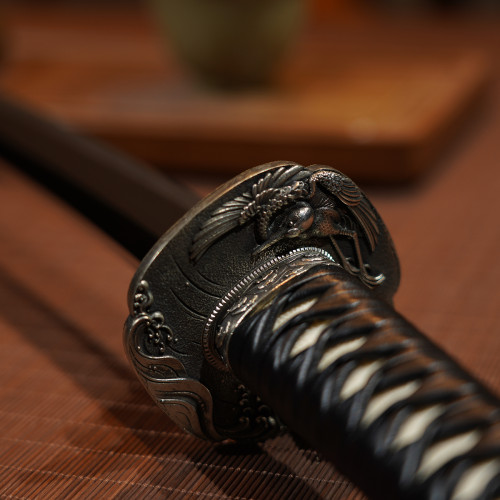Cart
- Quantity
-

-
- Product Name: LD Steel High Performence katana
- Item NO.: 1461105
- Weight: 2 kg = 4.4092 lb = 70.5479 oz
- Category: Swords > katana
- Brand: Dojo Tameshigiri Series
- Creation Time: 2023-12-19
-
Tameshigiri Katana has a hardness between 58-59HRC, and the impact toughness is 110J+, Vacuum heat treatment. It is polished by hand, and the overall hardness is too high, so it’s difficult to completely polish away the scratches on the surface. Therefore, compared with traditional art swords, its polishing looks not so beautiful. Its Hamon is a fake straight hamon made afterwards, in order to increase its beauty.
-
The impact toughness of our tameshigiri katana LD is 59HRC. And the cost to make 59 or 60 is also the same. Then why don’t we make it into 60HRC? (I know some of you always pursue hardness and consider higher hardness is better.) Just because the katana is too long and it’s heat-treated overall, the impact it receives during chopping is too strong, incomparable with a short sword. Therefore the key point is to make it difficult to fracture. And reducing the hardness can greatly increase the fracture toughness, making it not that easy to fracture. (hardness dropped a bit, while fracture toughness increased a lot.) That’s why we make it 59HRC. I think we must get rid of the inherent thinking of short swords. Hardness is not always right. The difference between a short sword and a long sword are like the difference between a sports car and an off-road vehicle. They are completely different.
The advantage of modern high-performance materials when making tameshigiri katana sword is that they are more durable and have better sharpness retention. When test chopping, it is best to cut only bamboo and mats, because bamboo and mats will not let the blade get V-shaped notches.
LD is a high quality and high toughness cold work die steel, with high crack resistance and abrasion. Its bending resistance, toughness, and many other indicators exceed CPM-3V, especially the toughness index. Under the same hardness of 60, the impact toughness of LD is about 115J, and CPM-3V is 95J. They also have almost the same wear resistance, but the anti-rust performance is far behind CPM-3V. However, its price is much lower than CPM-3V. We have tested CPM-3V making standard katana, after bending resistance , side shot, and finally, the blade broke when hitting the back of the blade without a notch. This didn't happen with the LD. That's why we gave up on making the CPM-3V steel tameshigiri katana. Maybe we would use CPM-3V steel making tanto and wakizashi.

-
-


-
——————————————-
<Koshirae>
——————————————-
■Tsuba:Iron
■F&K:brass
■Menuki:brass
■Seppa:Brass
■Habaki:Brass
■Tsuka:Haichi Style
■Tsuka Samegawa:White Real Rayskin
■Tsuka Ito:Fake Silk Ito
■Mukugi:1
■Kurikata Shitodome:Brass
■Saya Style:Oil Lacquer
■Sageo:Thickened Sageo
——————————————-
<Blade>
——————————————-
■Nagasa:71CM
■Motohaba:3.2CM
■Motokasane:0.7CM
■Sakihaba:2.4CM
■Sakikasane:0.4CM
■Sori:About 1.5CM
■Tsuka Length:26CM
■Bohi:No Bohi
■Material:LD Steel
■Hamon Style:Fake Suguha Hamon
■Blade Style:Shinogi Zukuri
■Heat Treatment: Vacuum heat treatment.
■Weight with/without Saya :1179g/1010gWarning:The data is just for reference because the handmade products’s data has error.
——————————————-
<Polishing>
——————————————-
■Polishing:Ordinary mirror polishing
——————————————-*******************************************
-
You May Also Like
-
 Wing Tamahagane Katana (Handmade Saya) by ZseyUS$ 3260.00
Wing Tamahagane Katana (Handmade Saya) by ZseyUS$ 3260.00 -
 Ko-choji Katana by ZseyUS$ 899.00
Ko-choji Katana by ZseyUS$ 899.00 -
 Muramasa Wicked Katana Sword - Replica by ZseyUS$ 2999.00
Muramasa Wicked Katana Sword - Replica by ZseyUS$ 2999.00 -

-
 Tamahagane Katana Blade(鹤波拵)by ZseyUS$ 3400.00
Tamahagane Katana Blade(鹤波拵)by ZseyUS$ 3400.00 -
 Nami Koshirae Wakizashi by ZseyUS$ 849.00
Nami Koshirae Wakizashi by ZseyUS$ 849.00 -

-
 Cherry Blossom Koshirae Kobuse Katana by ZseyUS$ 1380.00
Cherry Blossom Koshirae Kobuse Katana by ZseyUS$ 1380.00
Subscribe To Our Newsletter
- Company Info
- Feedback
- Customer Reviews
- About ShadowDancer Team
- Contact Us
- Material for ShadowDancer-Sword
- News
- User Center
- Forget Password
- My Orders
- Tracking Order
- My Account
- Register
- Payment & Shipping
- Shipping Methods
- Payment Methods
- Purchase Notes
- Company Policies
- Privacy Policy
- Terms of Use
- Become a Dealer
![]()
Copyright © ShadowDancer Sword 1998-2023 SHOP INC. All Rights Reserved.




Customer Reviews